Desert agave is renowned for its green fleshy and pointy leaves. They belong to the family Agavaceae and they are originally from America.
You could easily spot them on rocky surfaces. Lets find more about this majestic plant
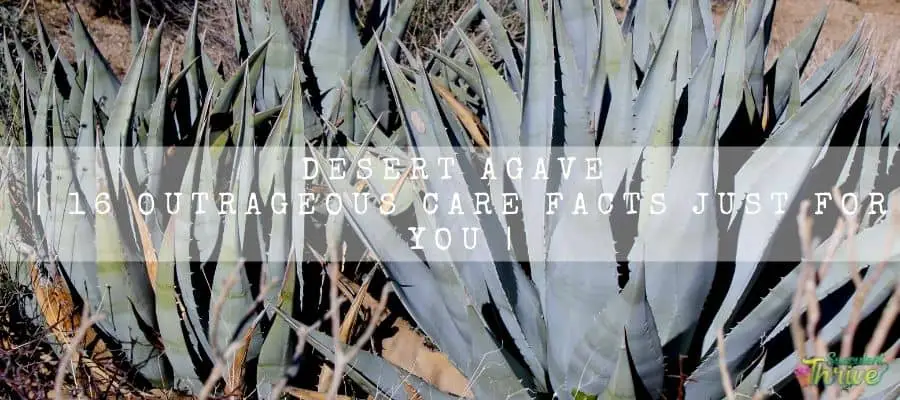
How do I identify desert Agave?
Same as other agave plants Desert agave leaves also form a rosette. They would be gray green in color and 20-70cm in length while their width would be around 4.5 cm – 10 cm.
Moreover, they will consist of sharp spines on their edges. Desert agave leaves will carry a vibrant blue tinge.
Underneath the leaves would be convex, and the top would be concave. The teeth of the leaves would be dark in color. Moreover, they would be one third of an inch in length.
Matured Desert agave would come up with short stems. Rest of the other Desert agave would grow without a stem.
Further you could use their flowering activity to identify these plants. In fact, Desert agave start blooming when they are about 20 to 40 years old. Those flowers would be yellow.
Moreover, desert agave flowers would tend to take a funnel shape and would be about 3-6 cm in length. Their inflorescence would be 2.6 m in height.
Their flowering season would be in early summer to mid-summer, and they would arise in spaced clusters in the edges of the stalks.
Size of the plant
Desert agave would rise to 70 cm (27 inches) in height. Further they would be about 10 cm (4 inches) in diameter.
Growth rate
Desert agave are slow growing plants.
One look care guide
| Botanical Name | Agave Desert Agave |
| Common Name | Desert Agave, Maguey De Desierto |
| Plant Type | Succulent |
| Mature Size | 70 cm (27 inches) in height. 10 cm (4 inches) in diameter. |
| Sun Exposure | Full Sunlight to partial sunlight |
| Soil Type | Well-draining, sandy |
| Soil pH | be 6.1-6.5 (mildly acidic) 6.6 – 7.5 (Neutral). |
| Bloom Time | Summer |
| Flower Color | Yellow |
| Hardiness Zones | USDA hardiness zones 7b- 10b |
| Native Area | America |
| Toxicity | Toxic |
| Average price | $ 15 |
How do you take care of the desert Agave?
Light Requirement
Desert agave requires full sunlight to perform well. When you grow them outdoors, you could grow them in a sunny spot where they can get both full sunlight and partial shade.
Since this is a big plant I suggest you plant this only outdoors.
Temperature and humidity
Desert agave are fond of growing in temperatures around 70 degrees Fahrenheit (21 degrees Celsius) – 90 degrees Fahrenheit (32 degrees Celsius) during spring and in summer.
On the other hand, they are hardy until 50 degrees Fahrenheit (10 degrees Celsius) – 60 degrees Fahrenheit ( 15 degrees Celsius) during autumn and winter.
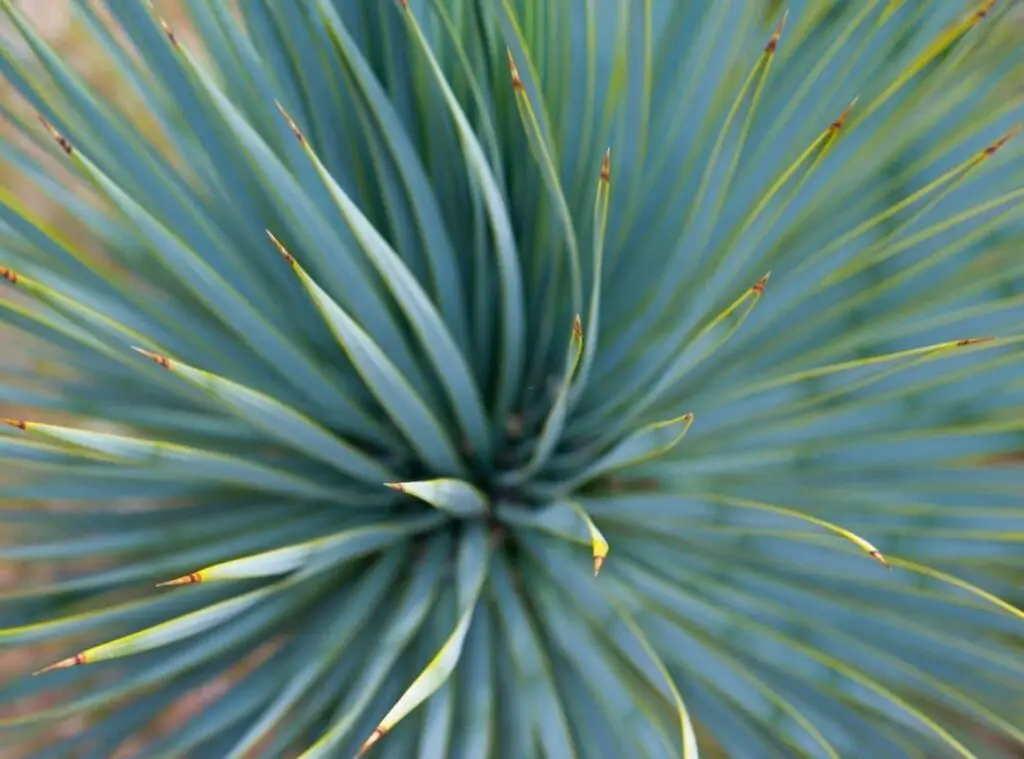
Is it cold hard?
Desert agave is not cold hardy. Having said that, they could handle more cold than the other agave plants.
USDA Hardiness Zone
Desert agave could survive in USDA hardiness zones 7b- 10b.
Watering Requirement
Watering the Desert agave is quite important when you take care of them well. Further When it comes to watering the Desert agave plants, you need to first observe the soil condition and only then resume water.
You should water them only if their top layer of the soil is dry only. Having said that you need to make sure that you do not let the soil become bone dry at any given point.
Literally when you spot the soil is dry, you should start watering them.
On the other hand, when you water the Desert agave during winter and in autumn you should minimize watering them and water them lightly.
If you end up providing excess water for them particularly during winter, it could create severe repercussions such as root rot in the plants. In addition to that, it could attribute the plant’s leaves to become pale in color.
Soil Requirement Type / pH
When it comes to selecting the right soil mix to grow these plants, Desert agave has a unique requirement, and it is in contrast to the rest of other ordinary plants’ soil requirements.
Desert agave are fond of growing in a well-draining soil mix.
In case if you are using a soil mix which does not have an excellent draining, that will retain excess moisture in the soil mix and make the plant more vulnerable for bacterial and for fungal infections.
Hence it is important that you grow them in the right soil mix . In addition to the excellent drainage, the soil needs to be porous and light as well. Further it needs to have a proper aeration too.
You may go ahead and plant them in a succulent soil mix or in a cactus soil mix as that would be quite easy.
Further it would suit them the best too.Ideal ph should be around 6.1-6.5 (mildly acidic) 6.6 – 7.5 (Neutral).
Flowering and Fragrance
Desert agave blossoming could take place during summer. However, they need to be matured enough to produce flowers.
Those flowers would be yellow and orange. Moreover, they would tend to take a funnel shape as well. Desert agave flowers would be 3-6 cm in size. Furthermore, their blooms will form in clusters.
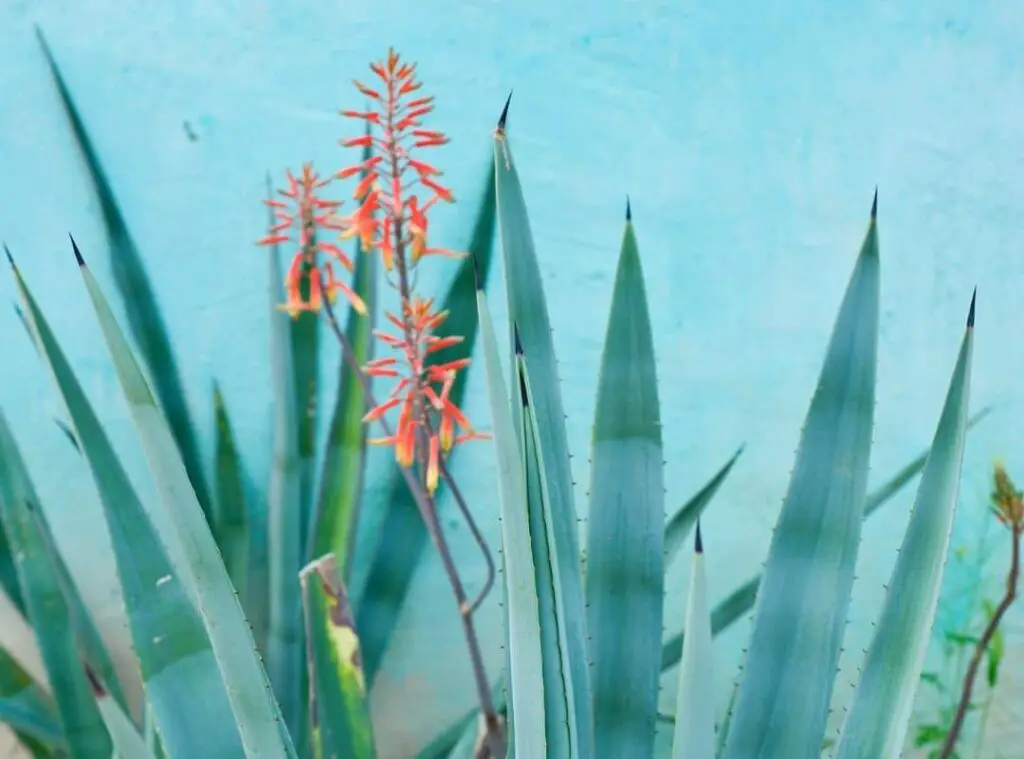
Pot size Potting and Repotting
You could go ahead with terracotta pots to grow them. However, what is more crucial is to find a pot which has a draining hole at the bottom of the pot.
Further the pot size should be slightly larger than the plant size.
As you now know, dessert agave is a big plant. Therefore you can consider planting it on ground rather than in a pot.
Otherwise you have to face big problems when they are repotting and moving from place to place.
Where to Plant
You need to ideally plant them in a bright sunny spot where they can fulfill their lighting requirement. Further, you need to grow them in a well-draining soil mix.
Fertilizer and time of year
You may apply fertilizers for these plants during autumn and in winter. Further you could proceed with a fertilizer which is more like a standard liquid fertilizer.
You could apply fertilizers once every two weeks biweekly during their actively growing seasons (in spring and in summer ).
Dormancy
Desert agave goes dormant in winter. During this season, plants will stop growing and literally they will be in sleeping mode.
Other plants Pairs Well With
You could grow Desert agave along with Barrel Cactus (Ferocactus cylindraceus).
Can it be toxic to pets
Desert agave could be toxic for pets and for humans as well. They consist of a toxic sap which could harm you. Hence take precautions when interacting with these plants.
Handling the plant
You should be careful when handling this big plant. Take necessary precautions when moving thi plant from place to place.
Always do the moving with the help of a friend or a family member.
Also you have to be careful about their marginal spines. They can not seriously injure you. But be careful when handling the plant.
Common bugs and illnesses
Desert agave are usually resistant towards pests and disease problems. Having said that, they may also encounter pests’ attacks from mealybugs and from scales.
You need to watch out for those pests, and it is important that you conduct regular check ups on the plants so that you could see if there are any early signs of any pests’ attacks.
It is important that you identify these issues well in advance since then it will be easy for you to overcome them.
Apart from that, root rot could be another major issue of these plants. Over watering could mainly attribute this condition and chances are that it could even kill the plants.
Special Care tips
You need to be careful when handling these plants since they have spines and sharp edges which could harm you. Hence you need to protect yourself first and then interact with the plant.
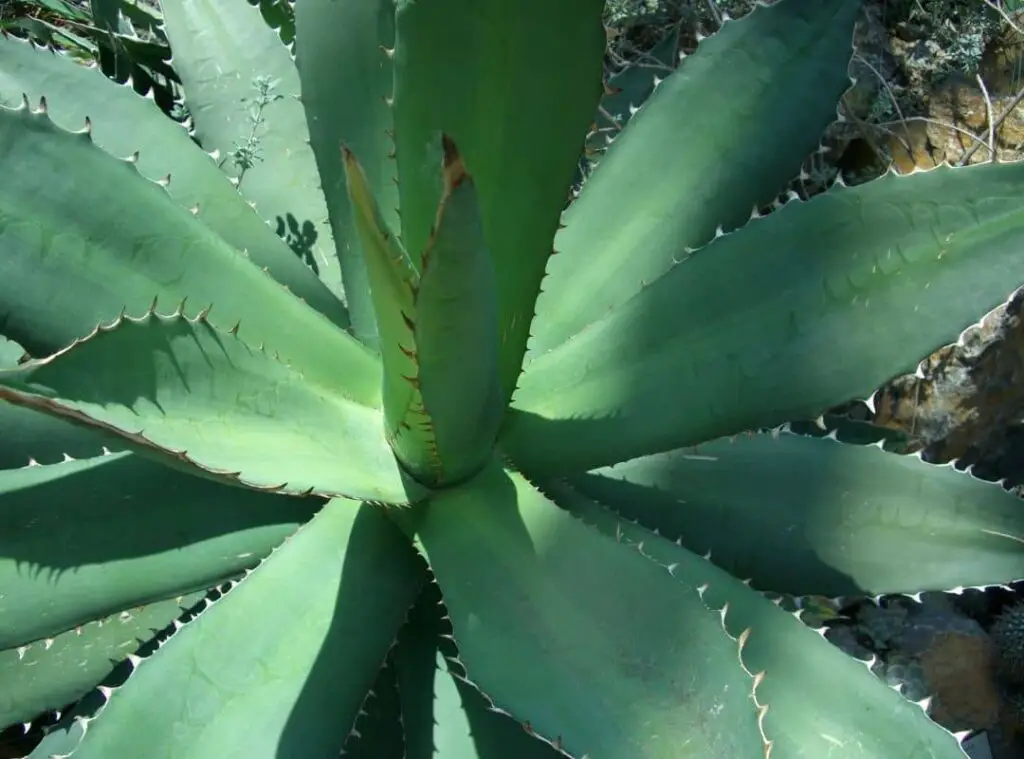
How to propagate desert Agave
Propagation of Desert Agave by Leaves
You may use Desert Agave plant leaves to propagate them. To do that you have to first take off a few leaves which are plump and healthy.
When taking them off, ensure that you are taking off only healthy-looking leaves. Moreover, you need to obtain the whole leaf without leaving any part of it in the mother plant.
Next, let those leaves become callous for a couple of days. Once they develop calluses, you may place them in a well-draining soil mx. That’s about it!
Propagation of Desert Agave by Cuttings
If you wish to practice this method, you could first cut a leaf from the mother plant whilst using a disinfected knife or a pair of scissors.
Once you obtain those cuttings, leave them in a dry place where they can develop callous. After that you may plant them in a well-draining soil mix just as in the above method.
Consider watering them whenever you spot the soil is dry.
Propagation of Desert Agave by offsets
It is a fairly easy process to propagate the Agave through offsets.
This is in fact the fastest and the most guaranteed way of propagating the desert agave plants. As aforesaid, these plants usually form pups around the base of the Desert Agave plants. You could easily remove them to start a new plant.
Apart from the above, you could use the seeds of the Desert Agave plants to multiply these plants too. You may use a sterilized soil mix which consists of perlite, sphagnum peat.
You could place those seeds in the soil mix and leave them in a warmer place where they can gain indirect sunlight. Make sure that you keep the soil moist until the plants establish.
You could consider placing a plastic cover for a couple of weeks which helps the soil to stay moist until root formation takes place. Once they form the roots, I recommend misting them.
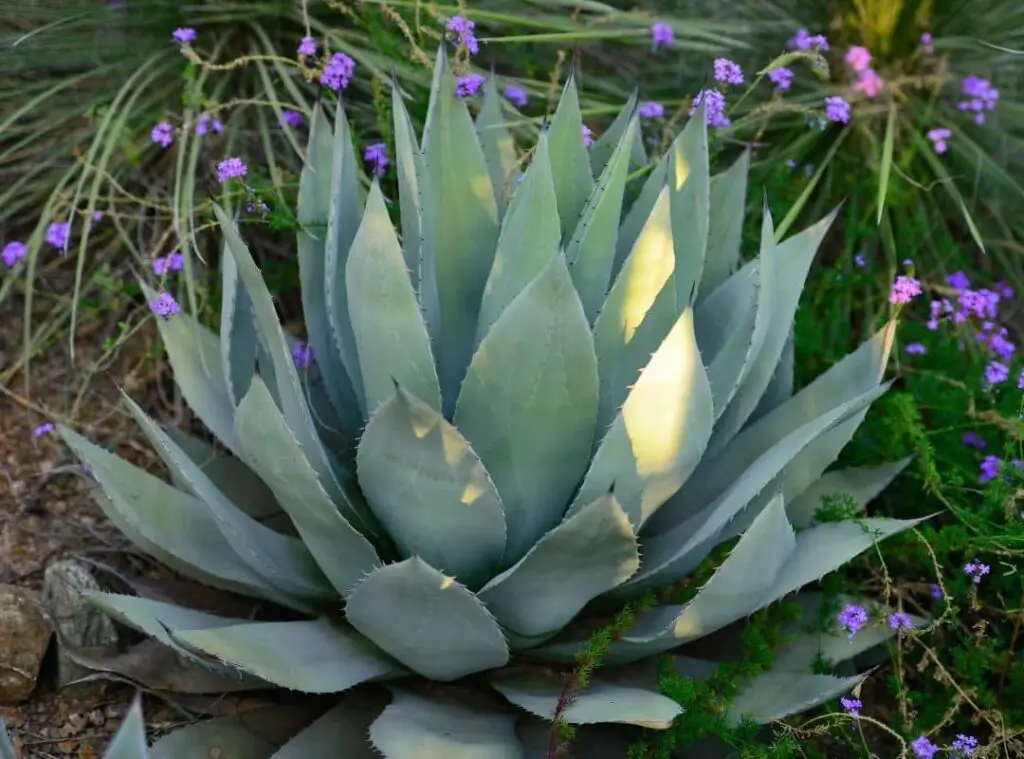
Desert Agave plant benefits
Desert Agave are useful as ornamental plants. In addition to that they could be handy picks for landscape borders, native plant gardens and for rock gardens as well.
Not only that you could use them for cactus and for xeriscape plantings too.
Desert dwelling Americans use these plant leaves fibers to produce cloth bowstring and ropes. Further they used some of the plant parts for their consumption as well.
The people in Cahuilla used this as one of the main food staples too. They are quite tasty plants due to low components of smilagenin and sapogenin.
Having said that, you need to safeguard these plants from the gophers.
Desert agave could withstand cold conditions more than the rest of other many agaves. Not only that but also, they are deer resistant too.
Conclusion
You could grow them in a well-draining soil mix along with low humidity levels.
Desert agave are special plants since they are oasis to desert dwellers and further, they could be useful for several other species’ survival as well.
Americans used the fibers from their leaves to produce cloth bowstrings and ropes. Further they used to consume the young flower stalks, flower stalks and plant buds as well.
Before wrapping up, trust you were able to enhance your knowledge on the Desert Agave plants and clear all your doubts on this.
To sum up you simply have to provide their basic growing requirements and they will grow to their fullest potential.
You could easily care for them. Further as aforesaid, their propagation is also easy too. So, hurry up and start growing your own Desert Agave plants.
Read Next : Agave Red Edge | 14 Astonishingly Simple Care Tips |
